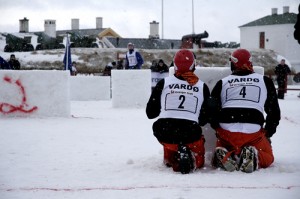Japanese Snowball Fighting
By Chelsea Thornton (Staff Writer) – Email
 The snowball fight is a timeless winter tradition. Every year, kids across the snow-receiving countries of the world gather to build forts, mould snowballs, and pelt each other with icy snow. The appeal of this parent-approved violence is so great that in some snowless countries, kids have resorted to using elephant dung to achieve similar satisfaction. Apparently kids aren’t the only ones who harbour a secret desire to imagine themselves lords of a battle fort, hell-bent on the destruction of the forces of evil that threaten their realm – adults also feel the need to pummel each other with icy balls, although they get more organized and high-tech about it. Enter Yukigassen, from the Japanese yuki, meaning snow, and kassen, meaning battle.
The snowball fight is a timeless winter tradition. Every year, kids across the snow-receiving countries of the world gather to build forts, mould snowballs, and pelt each other with icy snow. The appeal of this parent-approved violence is so great that in some snowless countries, kids have resorted to using elephant dung to achieve similar satisfaction. Apparently kids aren’t the only ones who harbour a secret desire to imagine themselves lords of a battle fort, hell-bent on the destruction of the forces of evil that threaten their realm – adults also feel the need to pummel each other with icy balls, although they get more organized and high-tech about it. Enter Yukigassen, from the Japanese yuki, meaning snow, and kassen, meaning battle.
The Showa-Shinzan International Yukigassen exclaims: “Protect yourself from snowballs and attack your opponent with snowballs. Yukigassen is a winter sport that overwhelms the world!” The Japanese are responsible for transforming a schoolyard game into a competitive sport. Two seven-man sides compete in an amalgamation of capture-the-flag and a snowball fight. The game consists of three three-minute periods, and the first team to win two-periods claims victory. Each team gets 90 snowballs per period. To win a period, you must either capture the other team’s flag or hit each of the other team’s players with a snowball.
Yukigassen was born of one town’s desire to extend their tourist-based economy into the winter months. Sobetsu, a town on Mount Showa-Shintzan, is a popular summer destination, but tourists abandoned the town during the winter. A committee was formed to develop a central event that would revitalize the winter economy, and ultimately decided that a snowball tournament would be a powerful attraction. Snowball fighting was able to go pro because of the invention of a ‘specially designed octopus dumpling-style snowball maker,’ and in 1989, the first Showa-Shintzan International Yukigassen was held, attracting 70 teams and 7000 visitors. In 2010, the 22nd Yukigassen attracted 128 teams and 25,000 visitors.
As Yukigassen has grown in popularity in Japan, it has also gone international. There are now official Yukigassen organizations in Canada, USA, Sweden, Norway, Holland, Finland, as well as Japan. The winners from the national competitions in each of these countries ultimately compete at World Championships in Japan. Currently, competition in Canada is limited to Saskatoon and Edmonton, although Yukigassen Canada has a five-year expansion plan that will bring the sport to cities in Ontario, Quebec, Manitoba, Nova Scotia, Saskatchewan, Alberta, and British Columbia. The BC towns currently slated for the event are Whistler and Big White. The sport also appears to have piqued the curiosity of the media and has been mentioned in The Wall Street Journal, The Edmonton Journal, Men’s Health, and has even appeared on Global News.
The downside to the sport is definitely that all players must wear helmets complete with full face guards. Where is the fun of a snowball fight without the possibility of an occasional face-wash?


